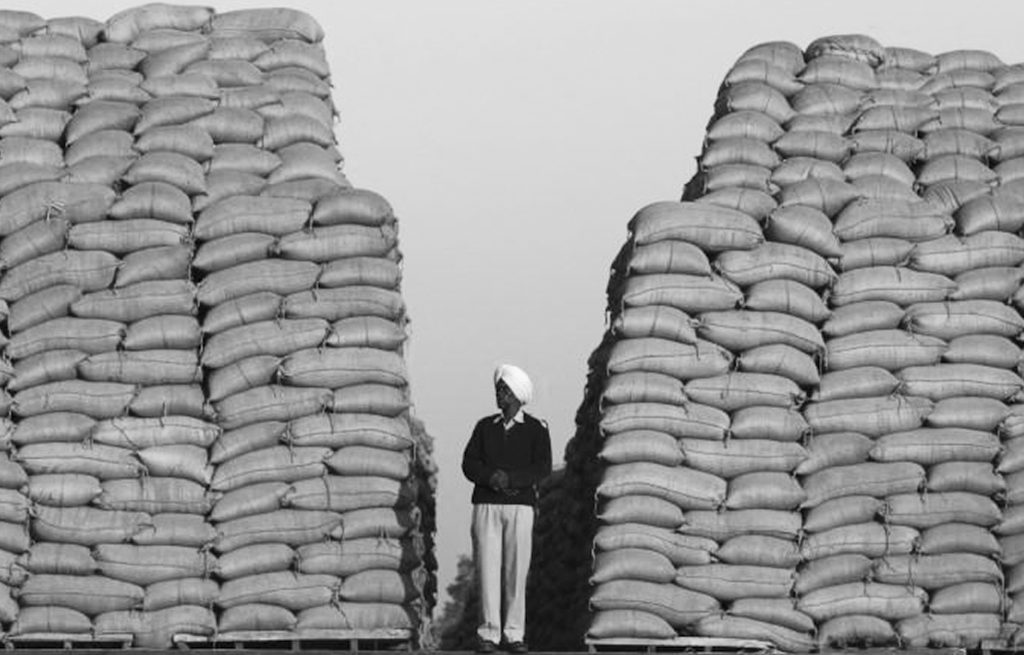Ajit Ranade
The official stock of foodgrains with the Food Corporation of India stood at 77.7 million tonnes as on March 1. This included 27.5 million tonnes of wheat and 50.2 million tonnes of rice. The rice estimate includes a significant quantity of unmilled paddy. This mountain of grain is among the highest level that the government has held in its stock. It is far in excess of what is required by the norms defined by the government itself. And this large stock is prior to the coming rabi harvest, which is expected to be bumper, and will add further to the stock. The coexistence of high stocks with the government amid rising hunger and starvation, is a peculiarly Indian phenomenon; and this is not the first time such an anomaly is noticed.
Foodgrain procurement and public distribution system (PDS) are designed to meet three objectives: food security, food price stability and adequate remuneration to farmers with minimum support prices. There is an inherent inadequacy in using just one instrument to achieve all the three objectives. Add to this factors, such as inefficiency of the bureaucracy, lack of coordination between central and state agencies, pilferage and wastage, lack of storage capacity and knee-jerk policy responses, and it is no wonder that this elaborate system has failed to address the problems of hunger and nutrition.
Last year, India’s global rank in the hunger index slipped nine places to 102 among 117 countries. The government has argued that the methodology was flawed and data outdated; but even by its own admission, India’s rank would be 91, hardly a matter of pride.
During the COVID-19 pandemic, food insecurity has become more acute. Millions of migrant workers and their families were migrating back from cities such as Delhi, Mumbai and Surat after the 21-day lockdown was announced. Since public transport was unavailable, many chose to trek hundreds of kilometres back to their villages. State governments then set up shelters and food distribution centres to mitigate suffering of these migrants who lost jobs, income and livelihood. These are the vulnerable sections exposed to food insecurity and loss of livelihood. States are desperately trying to prevent migrants from returning, not only to prevent COVID-19 from spreading but also to ensure availability of labourers once the pandemic is controlled.
A PIL petition has been filed before the Supreme Court seeking immediate direction to the Centre to address the plight of migrant workers and their families. The government, in turn, filed an affidavit in court describing the efforts private companies, NGOs and state governments were taking to serve more than 8.5 million people with food and rations. This is woefully inadequate. The number of people facing food insecurity could be upwards of 40 million. The long queues of people waiting to receive cooked food bear testimony to the seriousness of
the crisis.
The government has tried to be as responsive as possible, but it needs to do more. For instance, it must massively scale up involvement of partner NGOs who can help run community kitchens and provide cooked food or dry rations in cities and rural areas. But NGOs must be given foodgrains at a nominal PDS price or completely free, as also additional funds to buy cooking oil, vegetables and spices to meet costs of preparing food. So far, government orders specify that FCI will sell grain at Open Market Sale Scheme (OMSS) prices, which are higher than MSP and unaffordable to NGOs. Moreover, PDS rations must be given to both ration card holders and those without ration cards. Otherwise the food crisis will worsen and lead to starvation deaths or food riots. Grain allocation to families of migrants and urban and rural poor should be a lump sum equivalent to three-month quotas.
Those above the poverty line may also be headed for sporadic shortages of food during the lockdown. There are reports that flour mills are operating at 25 per cent capacity owing to the unavailability of wheat, workers or packaging material. The country has 2,500 units that have a combined production capacity of 25 million tonnes of flour, sooji and maida. Some have been forced to shut down owing to blockage of working capital in making biscuits and bread. Despite the government’s quick response in allowing truck movement, there are supply chain disruptions owing to uneven police action, or lack of coordination between various levels of government. It is unwise to categorise food as essential and non-essential. Who is to say that flour is essential and noodles is not?
Last August, a PIL petition was filed before the Supreme Court seeking the establishment of a national grid of state-funded community kitchens to cater to urban and rural poor, especially those who fall outside PDS. This was to combat worsening hunger and malnutrition in the country. The petition referred to initiatives of soup kitchens and canteens run in states such as Tamil Nadu, Andhra Pradesh, Uttarakhand, Odisha, Jharkhand and Delhi. These would complement mid-day meal schemes that serve hot meals to about 10 crore students daily. The government’s Poshan Abhiyan (Nutrition Mission), launched three years ago, has only spent 37 per cent of its budgeted funds as of December.
Clearly, eliminating hunger in India is a daunting task. In times of COVID-19, food security is in crisis. Fortunately, we have a mountain of grain, which, if quickly and intelligently utilised, can mitigate the crisis to a large extent. The government must not hesitate in transferring grain stock from the FCI to state agencies and NGOs at zero price, whatever be the fiscal implication.
©the billion press
The writer is an economist and senior fellow, Takshashila Institution.
